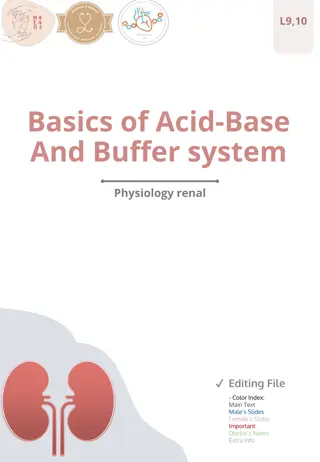Understanding Physiological Acid-Base Balance in Pharmaceutical Inorganic Chemistry
This lecture delves into the fundamental concepts of pharmaceutical inorganic chemistry, focusing on the mechanisms and uses of various pharmaceutical products that correct body disorders. Topics covered include acids and bases, intra and extracellular electrolytes, and the role of buffers in maintaining stable pH conditions in pharmaceutical preparations.
Download Presentation

Please find below an Image/Link to download the presentation.
The content on the website is provided AS IS for your information and personal use only. It may not be sold, licensed, or shared on other websites without obtaining consent from the author. Download presentation by click this link. If you encounter any issues during the download, it is possible that the publisher has removed the file from their server.
E N D
Presentation Transcript
Lecture No.3 Inorganic pharmaceutical chemistry Physiological acid base balance This lecture presents the basic concepts of pharmaceutical inorganic chemistry with emphasis on the description, mechanisms and uses of various pharmaceutical products which are clinically used to correct various body disorders. The major topics to be covered are acids and bases, intra and extra cellular electrolytes, the gastrointestinal agents and topical agents frequently employed in the conversion of drugs to chemical forms convenient to their product formulations.
Intra and Extra Cellular Electrolytes Generally, in the body, electrolyte concentration is maintained, but if the body can not maintain or correct the electrolyte balance, then it is done by external administration, which is known as replacement therapy. There are two compartments of body fluids: 1. Extracellular fluid (ECF). approximately 20% of total body weight. 2. Intracellular fluid (ICF). makes up 35-40% of total body weight. These fluid compartments are separated from each other by membranes. These membranes are permeable to water and certain inorganic and organic components present in the body fluids. Ali Albakaa 2
Acids and Bases: There are three distinct concepts of acids and bases (the Arrhenius concept, the Bronsted-Lowry concept and the Lewis concept). Arrhenius Acids and Bases: defined an acid as any compound that releases protons, H+, in water and a base as any compound that gives OH ions in water. Bronsted-Lowry-Acids and Bases: an acid is a proton donor and a base is a proton acceptor. Lewis Acid-Base: an acid is an electron pair acceptor while a base is an electron pair donor. pH Concept: pH as negative log of hydrogen ion concentration. To speak of acid or base strength, we need scales for acidity and basicity. pH = -log[H+], pH + pOH=14, pKw=14, (pH= 0-3 strong acid, pH= 3-7 weak acid, pH=7 neutral , pH=7-11 weak base, pH=11-14 strong base) Ali Albakaa 3
Buffers: an aqueous solution consisting of a mixture of a weak acid and its conjugate base or a weak base and its conjugate acid whose pH does not change on addition of small amount of an acid or a base, and do not change their pH values also on: Standing for a long time. Exposure to atmosphere. Slight dilution. A buffer solution is prepared by adding a solution of a weak acid to solution of one of its salts with a strong base. The buffer should not react with other chemicals in a pharmaceutical preparation, and it should not participate in redox reactions, alter the solubility of other components, form complexes with active ingredients, or participate in acid base reactions other than those required as part of the buffer function. Ali Albakaa 4
Role of Buffers in Pharmacy The buffers play an important role in pharmaceutical preparations to ensure stable pH conditions for the medicinally active compound. The following factors are influenced by the change in pH of any pharmaceutical compound/preparation: a) Solubility: Many inorganic salts such as ferric, phosphates, borates become soluble in acid media but precipitate in alkaline media. Many organic compounds with acidic functional groups are soluble in alkaline media. Similarly, amines and alkaloids are soluble in acidic media but are almost insoluble in alkaline media. b) Colour: The colour of many synthetic and natural dyes is pH dependent. e.g. red colour of cherry and raspberry is maintained in acidic pH and becomes pale yellow to nearly colourless in alkaline pH. Ali Albakaa 5
c) Stability of some compounds to redox conditions, the adrenaline with dissolved oxygen in the presence of alkaline medium, so its solution for injection is to be buffered to most stable pH range 2.5-5; ascorbic acid and penicillin are unstable in alkaline pH. d) Patient comfort: If the pH of injectable and preparations for internal or external use differs greatly from the normal pH, they become irritating for the patient. An extremely acidic or alkaline pH must be avoided to prevent tissue damage. Acid Base Balance Normal pH 7.35 7.45 Acidosis physiological state resulting from abnormally low plasma pH. Alkalosis physiological state resulting from abnormally high plasma pH. Acidemia : plasma pH less than 7.35 Alkalemia : plasma pH more than 7.45 Maintenance of Acid-Base balance a. Buffer systems. b. Elimination of some ions through kidney. c. through the respiratory system. Ali Albakaa 6
In the body, acids (either as carbonic acid from CO2 or lactic acid from anaerobic respiration) are constantly being produced during the metabolism. Since most of the reactions occur only with in a very narrow pH range (7.38- 7.42), the body utilizes several buffer systems. carbonic acid / bicarbonate buffer system in the plasma and kidneys. Phosphate buffer system in the cells and kidneys. Protein hemoglobin (Hb) buffer system in the red blood cells. Two of the main buffer solutions in the body are (HCO3 /H2CO3), and (HPO4 2 /H2PO4 ). There is also a buffer solution in (RBCs) red blood cells (HbO2- /HHb),which is the most effective buffer solution for the carbonic acid buffer solution produced during metabolic processes. Ali Albakaa 7
For each millimole of oxygen that dissociates from Hb, 0.7 millimole H+ is removed. H2CO3 + HbO2- + K+ K+ + HCO3- + HHb + O2 Due to various causes (reasons), the body s acid levels may increase and/or alkali levels decrease below normal, causing acidosis (pH = slightly below 7.38), or the acid levels may decrease and/or alkali levels may increase above normal causing alkalosis (pH slightly above 7.42). If the body can restore the pH back to 7.35-7.45 by alterations in the respiration and kidney function, it is referred to as compensated metabolic acidosis or alkalosis. Metabolic acidosis is treated with the sodium salts of bicarbonate, lactate, acetate and citrate. Administration of bicarbonate increases the (HCO3 /H2CO3) ratio when there is a bicarbonate deficit. If an excess of acid is liberated in the body it is neutralized by some of sodium bicarbonate . H+ + NaHCO3 Na+ + H2CO3 ( CO2 excreted by lungs ) H2O + CO2 Ali Albakaa 8
Lactate , acetate and citrate ions are normal compounds of metabolism and will be degraded to CO2 and H2O bytricarboxylic acid cycle (TCA cycle, citric acid cycle, Krebs cycle). The CO2 by the action of carbonic anhydrase will form bicarbonate and thereby reduce the HCO3- deficit. CO2 + H2O H2CO3 Na+ + H2CO3 Na+ + HCO3- +H+ The steps for acids acid excretion in the kidneys occur: 1. Sodium salts of mineral and organic acids are removed from the plasma by glomerular filtration. 2. sodium is preferentially removed from the renal filtrate or tubular fluid and, in the tubule cells, reacts with carbonic acid formed by the carbonic anhydrase- catalyzed reaction of carbonic dioxide and water. 3. NaHCO3 returns to the plasma and the protons enter the tubular fluid, forming acids of the anions. Ali Albakaa 9
Ali Albakaa 10
The phosphate buffer system is also effective in maintaining physiological pH, at pH7.4 the (HPO4 2 /H2PO4 ) ratio is approximately 4:1. In the kidneys, the pH of urine can drop to 4.5-4.8, corresponding to (HPO4 2 /H2PO4 ) ratios of 1:99 to 1:100. Ali Albakaa 11
The tendency to lower pH of the erythrocytes due to increased concentration of carbonic acid is compensated by hemoglobin; the bicarbonate anion then diffuses out of the erythrocyte and chloride anion diffuses in. this has been named the chloride shift. Ali Albakaa 12
The bicarbonate in plasma, along with the plasma carbonic acid now acts as efficient buffer system. The normal (HCO3 /H2CO3) ratio is 27/1.35mEq/L (20/1) corresponding to pH 7.4. In lungs there is reversal of the above process due to the large amount of O2 present. Oxygen combines with the protonated deoxyhemoglobin releasing proton. HHb + O2 HbO2- + H+ These combine with HCO3- forming H2CO3 which then dissociates to CO2 and water. The carbon dioxide is exhaled by the lungs. Thus by regulating breathing it is possible for the body to exert a partial control on the (HCO3-/H2CO3) ratio. Ali Albakaa 13
Ali Albakaa 14























